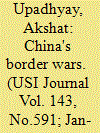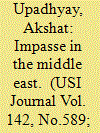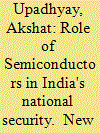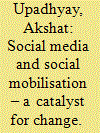| Srl | Item |
| 1 |
ID:
122033


|
|
|
| 2 |
ID:
190203


|
|
|
|
|
| Summary/Abstract |
Unmanned systems pose grave threat to several countries and their interests due to a number of reasons: low barrier of entry into the procurement sector, commercial availability off the shelf (COTS), ubiquity, persistence and low radar cross section (RCS). Due to this, counter drone systems have been either deployed piecemeal or existing air defence systems have been used to fill the gap. The Indian Armed Forces have a very limited experience of dealing with either drones or counter-drone systems in an operational environment. The Jammu attack using improvised drones was a wake-up call. With the impetus to indigenisation given through ‘Atmanirbhar Bharat’, this is an opportune time for the Indian defence industry to rise up to the challenge. However, it is equally important that certain guiding philosophies, based on other countries’ experiences, role of drones, threats posed and possible counter-measures be analysed so that a definite addition can be made in the drone literature in the Indian context. This article intends to do the same. By first briefly analysing the historical context under which the role of unmanned systems gained ground, followed by their unique characteristics and qualities, various counter-drone systems in vogue and case studies, the article attempts a prognosis on a practical counter-drone philosophy for the Indian Armed Forces, using a combination of academia and a practitioner’s perspective.
|
|
|
|
|
|
|
|
|
|
|
|
|
|
|
|
| 3 |
ID:
165569


|
|
|
|
|
| Summary/Abstract |
The Directorate General of Inter Services Public Relations (DG-ISPR), or the Pakistan Army’s media wing has perfected the form of subverting democracy and showcasing the dominant position of the Army in the entire Pakistani polity. This article sets out to prove the same in a quantified manner. By analysing almost 25 tweets from the official account of DG-ISPR in the period 2016 −18, the article tries to quantify, using the Merkel-Croissant model of embedded democracy, the priorities of the Pakistan Army. This article also provides a case analysis of some of the more controversial tweets and how DG-ISPR has succeeded in subverting Pakistani democratic institutions.
|
|
|
|
|
|
|
|
|
|
|
|
|
|
|
|
| 4 |
ID:
117564


|
|
|
| 5 |
ID:
189079


|
|
|
|
|
| Publication |
New Delhi, MP-IDSA, 2023.
|
| Description |
86p.pbk
|
| Series |
MP-IDSA Occasional Paper no; 61
|
| Standard Number |
9788195395798
|
|
|
|
|
|
|
|
|
|
|
|
Copies: C:2/I:0,R:0,Q:0
Circulation
| Accession# | Call# | Current Location | Status | Policy | Location |
| 060322 | 355.033054/UPA 060322 | Main | On Shelf | General | |
| 060323 | 355.033054/UPA 060323 | Main | On Shelf | General | |
|
|
|
|
| 6 |
ID:
172632


|
|
|
|
|
| Summary/Abstract |
This essay examines the features of social media platforms (SMPs) and their weaponisation by state and non-state actors alike. The author argues using a host of examples that the age of total war has diminished, if not obliterated completely. A state where every citizen is simultaneously a combatant and a target, a citizen’s war, has been the norm ever since the end of the Cold War. Use of SMPs has exacerbated various fault lines within societies. This has been adequately exploited by actors in Low Intensity Conflict Operations (LICO). Examples such as Hong Kong and Inter–Services Public Relations (ISPR) during the Balakot crisis come to mind. Finally, the author suggests structural, organisational and doctrinal changes by analysing various doctrines, joint and service-specific, to ensure that the Indian Armed Forces are better prepared to take advantage of this extremely potent tool, and use it not only for defence but offensive action too.
|
|
|
|
|
|
|
|
|
|
|
|
|
|
|
|
| 7 |
ID:
143075


|
|
|